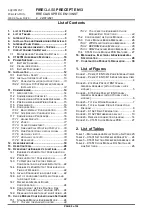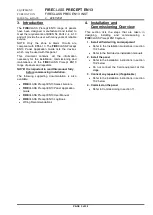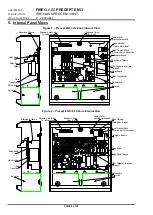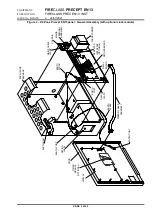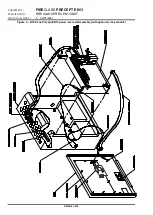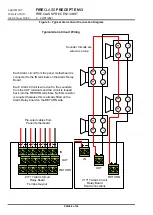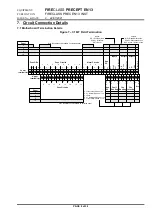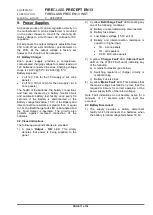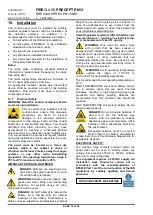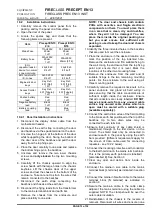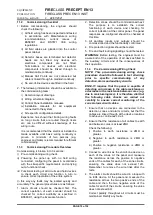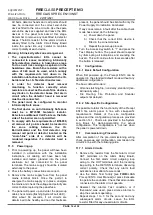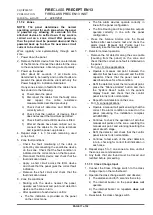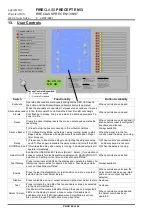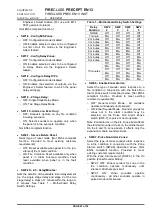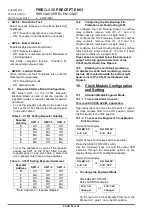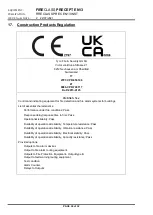
EQUIPMENT:
FIRE
CLASS
PRECEPT EN13
PUBLICATION:
FIRECLASS PREC EN13 INST
ISSUE No. & DATE:
2 22/07/2021
PAGE 15 of 32
11.2 Commissioning Checklist
1. Before commissioning, the engineer should
check the following:
i) All field wiring has been inspected and tested
in accordance with Manufacturer’s wiring
recommendations, current issues of
BS5839:1 and BS7671 IEE wiring
regulations.
ii) All field cables are glanded into the control
panel cabinet.
iii) Detector bases are terminated but detector
heads are not fitted. Any devices with
electronic components are not fitted.
Terminations to devices with electronic
components should be linked through to
maintain cable continuity.
iv) Manual Call Points are not connected but
cable is linked through to maintain continuity.
v) No end-of-line devices are fitted in the field.
2. The following information should be available to
the commissioning team:
i) Detection layout drawings.
ii) Wiring schematic diagram.
iii) Control Panel installation manuals.
iv) Installation manuals for all equipment
connected to the system.
v) Site specific configuration details.
Experience has shown that tracing wiring faults
on long circuits that are routed through risers
etc. can be difficult without knowledge of the
wiring route.
It is recommended that the electrical installer be
made available until basic wiring continuity is
proven. A minimum of two persons (e.g.
engineer and mate) is recommended for efficient
commissioning.
11.3 Commissioning Procedure Overview
Commissioning is broken in to 3 sections:
i) Pre-commissioning wiring check.
ii) Powering the panel up with no field wiring
connected, configuring the panel in accordance
with the site-specific requirements and carrying
out a functional check.
iii) Functional testing of all circuits and field devices
to check each circuit and function in turn to
ensure correct operation of the entire system.
In this way any faults may be located quickly and
accurately. The general procedures are as follows:
1. Alarm circuits should be checked first. The
correct operation of each sounder should be
checked for correct audibility as specified in
BS5839:1, using the Evacuate function.
2. Detection zones should be commissioned next.
The purpose is to establish the correct
functioning of each device and checking for
correct indication at the control panel. The panel
responses as configured should be checked at
this time.
3. All ancillary inputs and outputs should be
commissioned and the functionality confirmed.
4. Fire protection signals should be tested.
5. Fire and fault routing signalling should be tested.
WARNING:
Before testing, the engineer must be
aware both of the operation of all devices fitted to
the auxiliary circuits and of the consequences of
their operation.
11.4 Pre-Commissioning Wiring Check
NOTE: This pre-commissioning wiring check
procedure should be followed to test all wiring
prior to specific commissioning of any
detection, alarm and auxiliary circuits.
EN54-13 requires that the panel is capable of
detecting an increase in the cable resistance or
a decrease in the resistance between cores (e.g.
due to moisture ingress). It is therefore vital that
the following cable checks are carried out
carefully to ensure correct monitoring of the
zone & alarm circuit cables.
1. Ensure that no devices are connected to the
detection zones and alarm circuits, but that the
cables are linked through at the device locations
to achieve a continuous circuit.
2. Ensure that the resistance of all cables to earth
and between cores is at least 2M
Ω
.
Check the following:
i) Positive to earth resistance is 2M
Ω
or
greater.
ii) Negative to earth resistance is 2M
Ω
or
greater.
iii) Positive to negative resistance is 2M
Ω
or
greater.
3. Connect a wire link as the end-of-line device on
each of the zones. At the panel end, measure
the resistance across the positive & negative
ends of the cables for each of the zone circuits,
ensuring the value does not exceed 12
Ω
.
Remember to remove the wire links after the
tests.
4. The alarm circuits should be wired in a loop with
no EOL device. At the panel end, measure the
resistance across the two positive ends of the
cable and then the two negative ends of the
cable for each of the circuits, ensuring the value
does not exceed 6
Ω
.
Correct polarity throughout all circuits must be
maintained. Rectify any faults.


